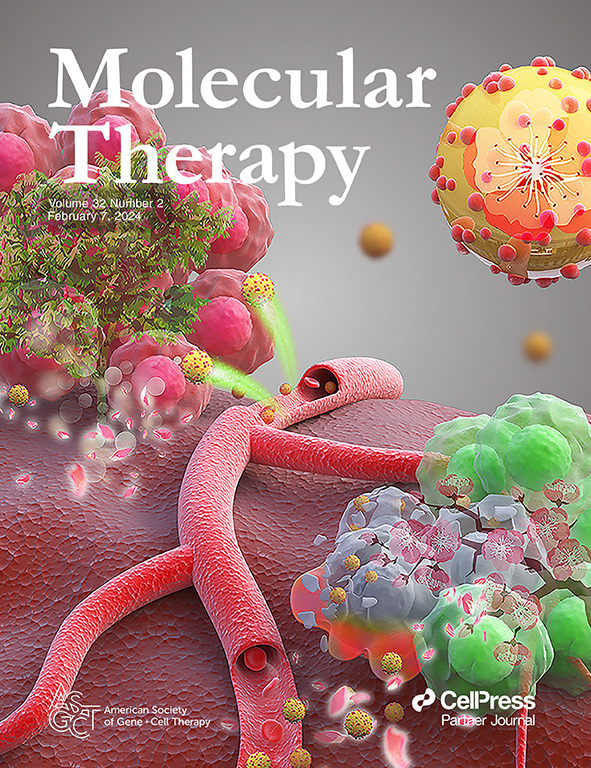嵌合酶通过造血干细胞基因治疗增强对白细胞营养不良的治疗潜力。
IF 12
1区 医学
Q1 BIOTECHNOLOGY & APPLIED MICROBIOLOGY
引用次数: 0
摘要
球状细胞白质营养不良(GLD)是一种由β-半乳糖神经酰胺酶(GALC)缺乏引起的致命溶酶体贮积症,可导致严重的脱髓鞘和神经变性,通常在两岁前死亡。造血干细胞/祖细胞移植(HSPC-T)的疗效有限,因为GALC不能充分传递到中枢和周围神经系统(CNS, PNS)和相关风险。使用腺相关病毒载体的体内基因治疗(GT)显示出希望,但安全性问题仍然存在。本研究提出了一种利用慢病毒载体(LV)介导的体外HSPC-GT与嵌合GALC酶的策略,该酶结合了α - l -伊杜洛糖酶(IDUA)和载脂蛋白E II (APO)的肽,以增强表达和血脑屏障渗透。在lv转导的HSPCs中,嵌合的IDUAsp.GALC.APO酶表现出比天然GALC和先前的嵌合变体更优越的生产和分泌,从而改善了GLD神经细胞中GALC活性的交叉校正和正常化。概念验证研究表明,GLD患者巨噬细胞具有有效的酶生成、分泌和交叉校正能力。体内实验结果显示,嵌合GALC在包括中枢神经系统和PNS在内的受累器官中具有稳定的基因标记、持续的酶生产和高效的递送。这些发现突出了HSPC-GT使用嵌合GALC酶作为治疗GLD的创新治疗方法的潜力。本文章由计算机程序翻译,如有差异,请以英文原文为准。
Chimeric Enzymes Enhance Treatment Potential For Globoid Cell Leukodystrophy through Hematopoietic Stem Cell Gene Therapy.
Globoid cell leukodystrophy (GLD) is a fatal lysosomal storage disorder caused by a deficiency in the β-galactosylceramidase (GALC) enzyme, leading to severe demyelination and neurodegeneration, and often death before the age of two. Hematopoietic stem/progenitor cell transplantation (HSPC-T) has limited efficacy due to inadequate GALC delivery to the central and peripheral nervous systems (CNS, PNS) and associated risks. In vivo gene therapy (GT) using adeno-associated viral vectors shows promise, but safety concerns persist. This research presents a strategy using lentiviral vector (LV)-mediated ex vivo HSPC-GT with a chimeric GALC enzyme that incorporates peptides from alpha-L-iduronidase (IDUA) and apolipoprotein E II (APO) to enhance expression and blood-brain barrier penetration. The chimeric IDUAsp.GALC.APO enzyme exhibited superior production and secretion compared to native GALC and previous chimeric variants in LV-transduced HSPCs, resulting in improved cross-correction and normalization of GALC activity in GLD neural cells. Proof-of-concept studies demonstrated effective enzyme production, secretion, and cross-correction capability of macrophages from GLD patients. In vivo results showed stable gene marking, sustained enzyme production, and efficient delivery of the chimeric GALC in affected organs, including the CNS and PNS. These findings highlight the potential of HSPC-GT using chimeric GALC enzymes as an innovative therapeutic approach for treating GLD.
求助全文
通过发布文献求助,成功后即可免费获取论文全文。
去求助
来源期刊

Molecular Therapy
医学-生物工程与应用微生物
CiteScore
19.20
自引率
3.20%
发文量
357
审稿时长
3 months
期刊介绍:
Molecular Therapy is the leading journal for research in gene transfer, vector development, stem cell manipulation, and therapeutic interventions. It covers a broad spectrum of topics including genetic and acquired disease correction, vaccine development, pre-clinical validation, safety/efficacy studies, and clinical trials. With a focus on advancing genetics, medicine, and biotechnology, Molecular Therapy publishes peer-reviewed research, reviews, and commentaries to showcase the latest advancements in the field. With an impressive impact factor of 12.4 in 2022, it continues to attract top-tier contributions.
 求助内容:
求助内容: 应助结果提醒方式:
应助结果提醒方式:


